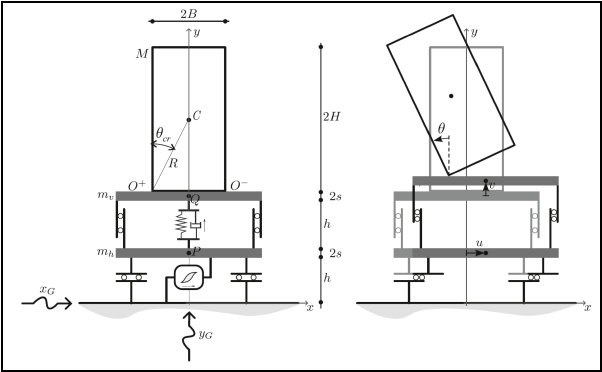D.I.C.E.A.A. - Dipartimento di Ingegneria Civile, Edile-Architettura e Ambientale
The effectiveness of the base isolation to reduce the seismic effects on rigid bodies, representing monolithic objects of art or rigid
equipments, has been investigated. The bodies have been modelled as a bi-dimensional slide-rocking rigid block posed on an oscillating
base connected to the ground by a linear visco-elastic device. In the study also the precence of security stops, able to prevent
the breaking of the isolation system and the possibility that the base of the body could go out the oscillatin support, have been
taken into account. The analysis has shown the good performance of the base isolation in comparison with the case where it is not
considered.
In this paper, a double, horizontal and vertical base isolation, is considered for the protection of rigid-block-like objects against
seismic excitation. The equations of motion, the uplift and impact conditions are obtained under the hypothesis that the block can
undergo full-contact and rocking motions. It is assumed that the horizontal isolation device has a hysteretic behavior, described
with the Bouc-Wen model, whereas the vertical isolation has a visco-elastic behavior, modeled through a Kelvin-Voight device. Three
rigid-block-like objects, representing a caryatid, a server and hospital cabinets are considered. Moreover, as base excitation, three
earthquake horizontal and vertical records are selected accounting for their spectral content and PGA. The results of the seismic
analysis are arranged in rocking maps and a comparison among the systems with the horizontal and vertical isolation, with only the
horizontal isolation, and with no isolation are performed to check the effectiveness of the proposed seismic protection. Results show
that the coexistence of horizontal and vertical isolation in protection against seismic excitation is particularly effective under
earthquakes with high vertical PGA and in objects with high slenderness and heaviness. Finally, an analysis that consists of exciting
the system with horizontal and vertical one-sine, impulsive base accelerations is performed to build the overturning spectra. Also,
in this case, the double, horizontal and vertical isolation has manifested better performances than the other analyzed systems.

















